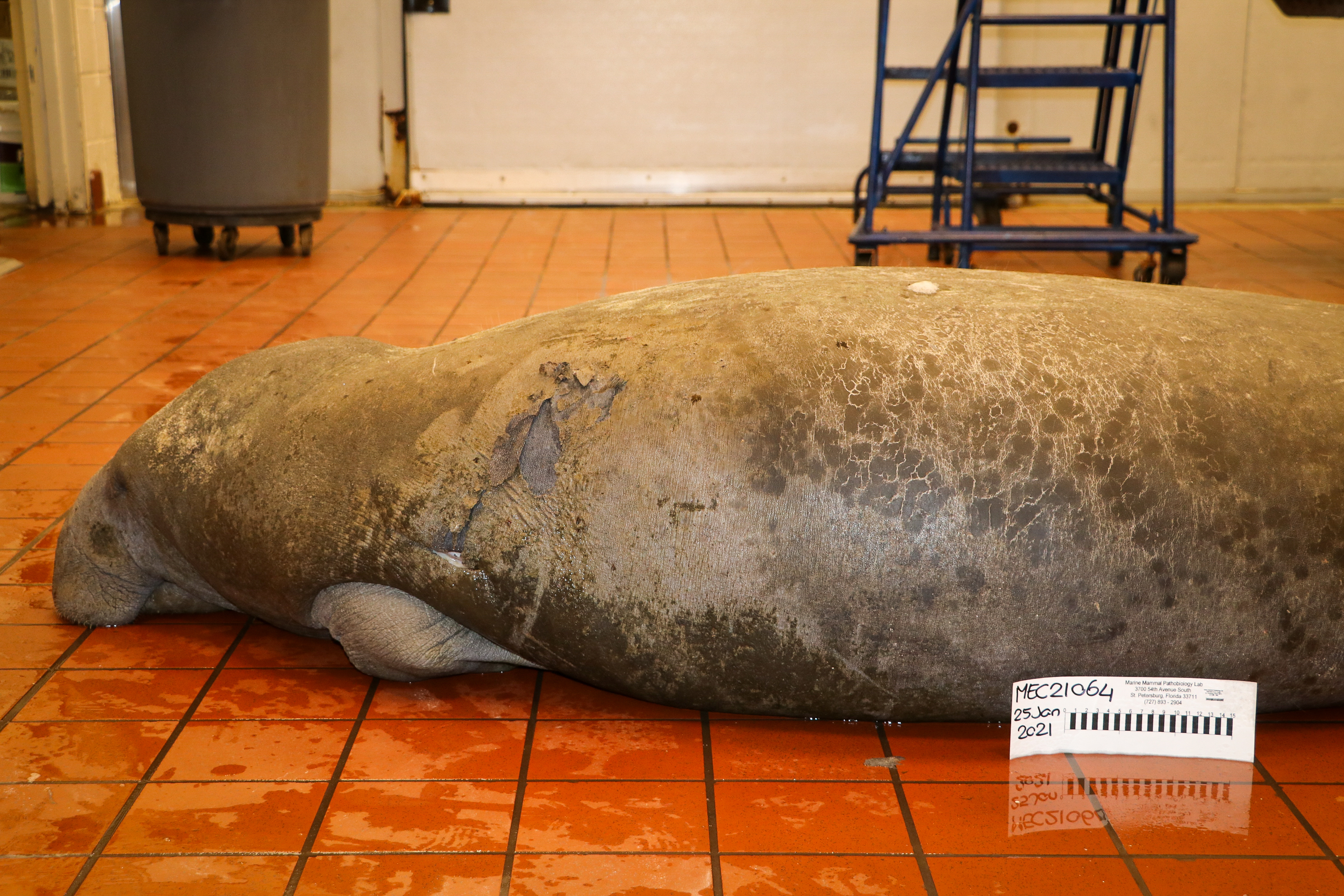Tampa Bay Times wins May Sidney for Sounding the Alarm About Florida’s Manatee Crisis
Zachary Sampson, Shreya Vuttaluru and Bethany Barnes win the May Sidney Award for “Wasting Away,” a Tampa Bay Times investigation into the mass die-off of manatees in Florida. The manatee is a gentle giant that spends its days grazing on seagrass in Florida’s waterways.
During the winter, many manatees congregate in the Indian River Lagoon, one of the nation’s most vibrant waterways, where they find warm water discharged from the local power plant. In 2021, dozens of manatee carcasses washed up in Brevard County. Experts quickly identified the culprit: pollution. Excess nitrogen and phosphorus runoff were killing off the seagrass meadows of the lagoon and the animals were starving to death. By spring 2021, 600 manatees had died across Florida, about 250 of them in Brevard County. By the end of that year, 1100 were gone.
Zachary Sampson covered the 2021 crisis. He wondered if other Florida waterways might be afflicted by the same pollution. This question led the team to a first-of-its-kind analysis of millions of sampling results from a state database to assess Florida’s water quality. They found that the state had failed to control pollutants for decades, allowing the Lagoon and hundreds of Florida waterways to become dangerously polluted. They determined that one in four Florida waterways was contaminated. The reporters conducted more than a hundred interviews with politicians, scientists and environmentalists, and over 140 public records requests from all levels of government.
Florida officials said conditions in the Lagoon have improved. But scientists caution that it is too early to celebrate, as the root cause of the problem has not been resolved; pollution levels remain too high.
“This investigation shows the power of data-assisted reporting to cast light on urgent environmental issues,” said Sidney judge Lindsay Beyerstein, “Florida regulators have been promising to improve water quality for years but this reporting shows their promises remain unkept.”
Zachary T. Sampson is an investigative reporter at the Tampa Bay Times who has covered the environment, breaking news and public safety. He’s reported on Tampa Bay’s unique flood risks, phony hiring reports at a local workforce agency and is part of the newsroom team that reports on the ground immediately after hurricanes.
Shreya Vuttaluru is the investigative data reporter at the Tampa Bay Times. She has reported on affordable housing projects, accessibility issues for people with disabilities and gun violence near schools in Baltimore, with work appearing in The Baltimore Banner, The Dallas Morning News, The Associated Press and The Washington Post.
Bethany Barnes is the deputy investigative editor at the Tampa Bay Times where she has reported on a school district’s failure to listen to teens’ sexual harassment complaints and an armored car company that flooded roads with unsafe trucks. She previously worked at The Oregonian and in Las Vegas, and she’s one of four journalists who put together Local Matters, a free weekly newsletter that rounds up the nation’s best local investigative reporting.

Backstory
Q: How did you become aware that Florida’s manatees are dying off in record numbers?
News of Florida’s manatee die-off broke in early 2021, as state wildlife officials found more and more emaciated animals washing up in the Indian River Lagoon. It became a major story across Florida. Sampson covered the breaking news as an environment reporter at the Tampa Bay Times. The coronavirus pandemic was still raging, and priorities shifted when Tampa Bay was hit by a major pollution spill of its own, followed by a devastating toxic red tide algae bloom.
But it was clear then that there was more to do — and dig into — on the manatee crisis. We wanted to know: If the Lagoon, one of America’s most vibrant waterways, could nearly collapse, what did that mean for the rest of Florida waters? And how was the state responding? We set out to connect the manatee die-off to broader environmental problems in a way no one had tackled before.
Q: What are the biggest threats to manatees in Florida?
Manatees do not have natural predators, but people threaten them in many ways. For decades, boat collisions have been a significant killer. Crashes are so common that researchers identify individual manatees by their scars. Development has destroyed habitat directly and blocked paths and places manatees once used to find warm water in winter.
Pollution is also an increasing danger. Runoff from farms and cities — products of Florida’s powerful agriculture and development industries — puts chemicals in the water that fuel algae blooms, which can kill manatees directly or destroy the seagrass they eat. To understand the threat, we tallied modeling results from state reports and found an estimated 100 million pounds of nitrogen and 4.5 million pounds of phosphorus could mar already contaminated waters each year. We also identified alarming levels of chemicals in nearly 1 in 4 Florida waterways.
Our analysis relied on monitoring results from thousands of stations and a statistical approach vetted by more than a dozen experts, including academics and former federal scientists. More than half of polluted waterways analyzed by the Times had levels of contamination that were either worsening or not getting better over roughly 25 years.
Q: Your team conducted an ambitious investigation to uncover the roots of Florida’s manatee crisis. Can you give us an overview of your investigative strategy?
We look for stories of harm and wrongdoing, where we can dig to reveal something new about the biggest problems facing Tampa Bay and Florida at large. We benefit from taking our time. We put in loads of records requests — more than 140 to state, regional and federal agencies for this story alone. We fight for the release of public information. During the course of this reporting, we had to turn to our attorneys multiple times to free records state agencies wouldn’t turn over. We interview dozens of people and analyze enormous datasets. The database of water monitoring samples contained more than four million results for the chemicals we examined. (Experts wondered whether Vuttaluru was pursuing a PhD by tackling such a complex analysis. One recommended that we publish our findings in an academic journal.) We question conventional wisdom and look for proof of what’s happening, why it’s happening and who can change it. Then we write draft after draft, trying to explain complex findings in simple, relatable terms.
Q: Why have conservation programs not been more effective?
We’re continuing to report on this question. The pollution that has devastated the Indian River Lagoon, where manatees starved, has been flowing — and escalating — for decades. Florida’s lawmakers and environmental leaders have been aware of the basic causes since the 1970s. But much of the runoff from agriculture and development that pollutes waterways isn’t subject to strict regulation or measured at its source. Efforts to curb the pollution are largely based on models, which are imperfect and often rely on outdated information. We found, for example, pollution levels to still be increasing in waterways where state regulators have reported significant cuts.
Q: Did anything unexpected happen in the reporting of this story?
For any story, we go in open-minded to wherever the reporting leads us. That said, we each had moments of revelation during the reporting — hearing about both how resilient and how vulnerable to the impacts of people manatees are; learning that much of the progress that Florida claims toward cleaning up pollution isn’t directly measured; reading stories from the 1980s and 1990s in which the quotes, and problems, sound nearly identical to the discourse around water pollution today.
Q: What did you learn from this investigation that you will carry forward to your next assignment?
Since our reporting on this subject is ongoing, there’s a lot of foundational information we’ll use in the future, including the methods to analyze trends in water pollution and Florida’s history of environmental regulation. Most importantly, the process — from reading more than 7,000 internal Florida wildlife agency emails to reviewing millions of rows of data — reaffirmed for us the importance of turning every stone and continually pressing for answers.
- ‹ Previous
- Next ›




